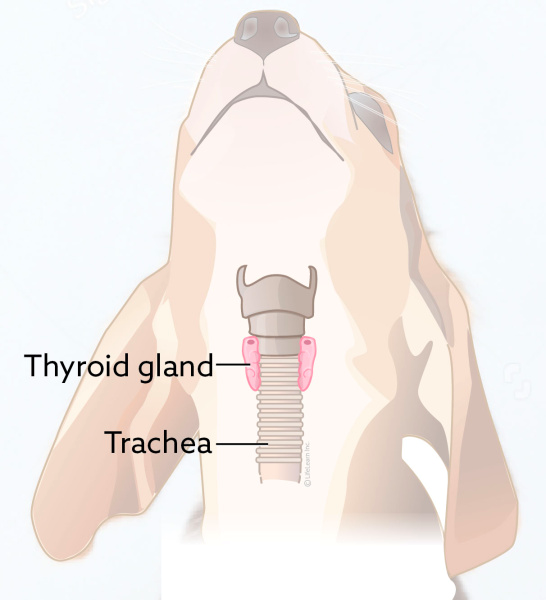Hypothyroidism in dogs
WHAT IS THE THYROID GLAND?
Dogs have 2 thyroid glands located in the neck on either side of the trachea. This gland produces thyroid hormones, crucial for regulating the metabolism of most of the organs in the body. In other words, the thyroid hormones control how fast the organs work depending on the amount of hormone produced.
WHAT IS HYPOTHYROIDISM?
If the thyroid gland produces less hormone than expected, the metabolism of the body will slow down. This is the foundation for the clinical signs of hypothyroidism. On the other hand, excess thyroid function is quite rare in dogs.
This disease can occur to any dog, male and females can be equally affected and it usually occurs in middle- aged pets, being medium to large breed dogs the more frequently diagnosed. There’s also some breed predisposition documented in Golden Retrievers, Dobermans, Dachshunds, Miniature Schnauzers and Cocker Spaniels.
There are 2 main reasons why the thyroid gland might be less active than expected:
- Lymphocytic thyroiditis → this is the most common cause of hypothyroidism in dogs. It’s related to immune mediated disease, where the thyroid gland is attacked by the dog’s immune system.
- Idiopathic thyroiditis → normal thyroid tissue is replaced by fat tissue, so the gland shrinks and decreases its functionality. The reason for this situation is poorly understood so far.
Other less likely causes of hypothyroidism are underlying diseases that might be affecting the pituitary gland, congenital defects, trauma or thyroid cancer.

Image source: VCA hospitals
WHAT ARE THE SYMPTOMS OF HYPOTHYROIDISM?
As the metabolism slows down, every organ will be affected by the lack of thyroid hormones. The symptoms observed might include:
- Weight gain without an increase in food intake
- Lethargy
- Cold intolerance (heat seeking behaviour)
- Skin signs → Dry hair coat with excessive shedding, recurrent skin and ear infections, thin haircoat to near baldness, increased pigmentation of the skin, failure to regrow hair after clipping, thickening of the skin around the face (tragic look)
- Reproductive signs → Loss of libido and infertility in intact males, lack of heat periods, infertility, and abortion in females
- Eye signs → Fat deposits in the cornea, dry eye (decreased tear production)
HOW IS HYPOTHYROIDISM DIAGNOSED?
Hypothyroidism is diagnosed with a blood test. Your vet will start with a complete physical examination of your pet and will get a blood sample for further investigation. The most common test to diagnose hypothyroidism is a blood sample that measures the total thyroxine (TT4) level, one of the hormones produced by the thyroid gland. If TT4 is low and your dog has signs of hypothyroidism, this is suggestive of the disease. However, some drugs or diseases might alter the TT4 levels in blood, which can lead to a misinterpretation of the blood results. It is for this reason that additional blood tests might be required to confirm the diagnosis of the disease.
IS THERE A CURE FOR HYPOTHYROIDISM?
Hypothyroidism is a treatable disease but it can’t be cured.
The treatment used is oral thyroid synthetic hormone, medication that needs to be given daily for life. To determine the correct dose of medication that your dog requires, we will need to recheck the bloodwork a few weeks after starting the treatment. If the T4 levels are back to normal parameters, it means that we are using the right dose. Please be aware that tolerance of medication may change over time, so your dog might require dose adjustments. It is for this reason that we recommend you to have your dog’s bloods checked every 6-12 months to ensure they are still using the appropriate dose of their medication.
Usually the signs linked to hypothyroidism improve once the thyroid levels have been restored to normal. You will be able to see an improvement of the signs within a few weeks, while the skin abnormalities might take up to several months to go back to normal.
Untreated hypothyroidism can shorten your dog’s lifespan and quality of life. However, dogs with hypothyroidism can live normal lives when the disease is properly managed with medication. This disease has an excellent prognosis and patients generally respond well to treatment, so if you are worried your dog may be showing signs that might possibly be linked to hypothyroidism, don’t hesitate to contact us!


